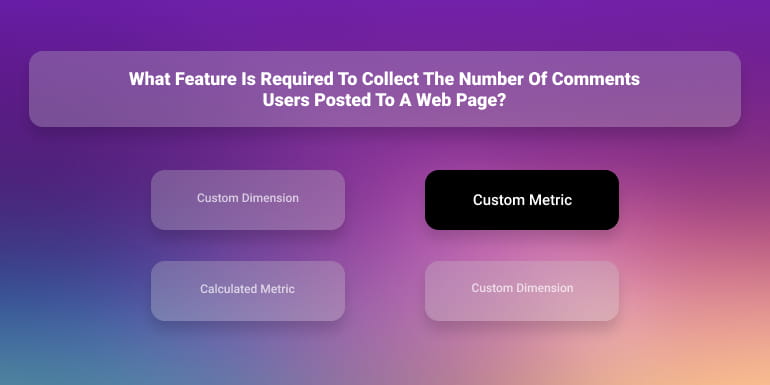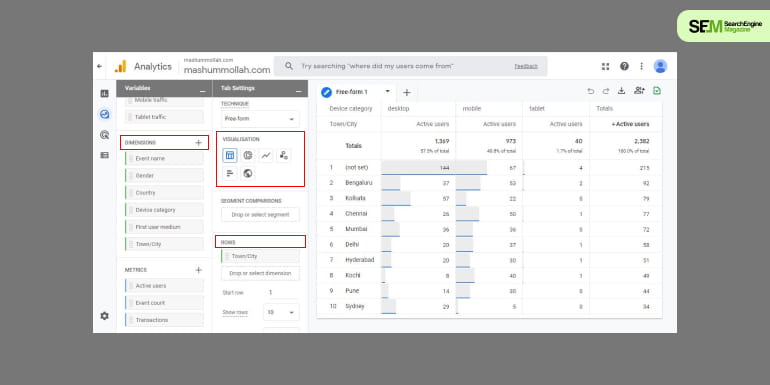How To Know If Someone Blocked You On iMessage? 5 Secret Hacks!
Apr 16, 2025

Apr 16, 2025

Apr 16, 2025

Apr 15, 2025

Apr 11, 2025

Apr 11, 2025

Apr 11, 2025

Apr 08, 2025

Mar 29, 2025
Sorry, but nothing matched your search "". Please try again with some different keywords.


Question: What Feature Is Required To Collect The Number Of Comments Users Posted To A Web Page?
Option 1: Custom Dimension
Option 2: Calculated Metric
Option 3: Custom Metric
Option 4: Custom Dimension
The right answer: Custom Metric
Are you taking baby steps in the world of Google Analytics? Then it’s quite common to have this question. Well, custom metrics is an incredible feature that helps you collect the number of comments users posted to a page. But don’t you want to learn more about it? Then keep reading till the end to learn more about what feature is required to collect the number of comments users posted to a web page?

The digital marketers, as well as E-commerce personnel, are simply in love with Google Analytics Custom Metrics. Do you know why? The first and foremost reason is that it gives you rich insights in terms of your online business.
So it is basically that metrics in your Google Analytics which allows you to collect distinctive website communications. The best thing about it is that you can develop the default metrics of your analytics account all by yourself.
Sometimes, it becomes extremely tedious to collect some particular data automatically. This is where custom metrics prove themselves to be useful. For instance, it’s tiresome to collect the users’ comments posted on a web page. This is the exact place where you can use the Custom Metrics tool.
So the answer to “what feature is required to collect the number of comments users posted to a web page?” is “CUSTOM METRICS.”

While speaking about Custom Metrics, it’s very obvious that the term “Custom Dimension” would arrive. Both of these are two robust tools for sending custom data to GA.
E-commerce persons and web developers use metrics and dimensions to divide and analyze several web-page data. What does it include? – Logged in/logged out times, page authors, and others. Whatever you try to learn on Google Analytics, you have to come across these two definitely.
 One of the most widely prevalent questions in relation to the Google Analytics Custom Metrics is about its scope levels. Precisely, this aspect is also related to Google Dimensions but let’s stick to the point on which our topic is focused.
One of the most widely prevalent questions in relation to the Google Analytics Custom Metrics is about its scope levels. Precisely, this aspect is also related to Google Dimensions but let’s stick to the point on which our topic is focused.
To know what scope applies to custom metrics, see the following section:

Indeed, custom metrics Google Analytics can be advantageous for your E-commerce business. Not one, but you can enjoy a plethora of benefits from it. How? Read the points below:
What Feature Is Required To Collect The Number Of Comments Users Posted To A Web Page- The Explanation
I hope you have understood what feature is required to collect the number of comments users posted to a web page. But why?
Because of custom metrics distinctive properly and in-built features, it can generate customized reports for your business website. Needless to say, two of the key attributes of these reports are flexibility and understandability. As a result, custom metrics is a pretty convenient tool to track website metrics like visitor’s comments.
So if you want to extract crucial metrics of your web page, close your eyes and have full faith in custom metrics.
Email comes under the “source” tag in Google Analytics by default as it falls under the “Medium” category.
At first, sign in to Google Analytics, Then click Admin and find the property where you would like to add custom metrics. Hit on the custom definitions and then custom metrics. Tap the New Custom Metric button. Then head on to adding a name.
Furthermore, from the Formatting Type drop-down list, select integer, Time, or currency.
Select and check the active box for collecting data. You can now extract the metric reports. Uncheck the box if you want to generate the metric but keep it inactive.
Finally, click on Create.
In GA, metrics are basically quantitative measures. They are data set numbers paired with the custom dimensions.
By now, you must have understood what feature is required to collect the number of comments users posted to a web page? So without any more ado, start exploring this feature right now and get rich, intriguing insights about your online business.
I am sure you have got broad perceptions on custom metrics and their usage in collecting comments from web pages. Do you have any additional queries or viewpoints about this? Drop them in the box below if you have any, and we will be more than happy to clarify those.
You May Check Also:
Mashum Mollah is the feature writer of SEM and an SEO Analyst at iDream Agency. Over the last 3 years, He has successfully developed and implemented online marketing, SEO, and conversion campaigns for 50+ businesses of all sizes. He is the co-founder of SMM.
View all Posts
How To Know If Someone Blocked You On iMessag...
Apr 16, 2025
7 Website Design Mistakes That Are Hurting Yo...
Apr 16, 2025
Programmable Dynamic SEO for Location-Based P...
Apr 15, 2025
Google Boba Game: How To Play This Fun Game B...
Apr 11, 2025
Which Is The Best Video Search Engine Of 2025...
Apr 11, 2025

